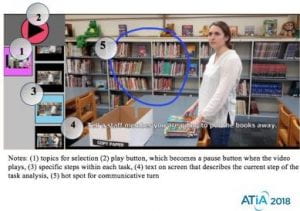 Babb, S., O’Neill, T., Gormley, J., Light, J., & McNaughton, D. (February, 2018). AAC Video Visual Scene Displays: Supporting Adolescents with ASD. Presentation at ATIA, 2018 Orlando, Florida.
Babb, S., O’Neill, T., Gormley, J., Light, J., & McNaughton, D. (February, 2018). AAC Video Visual Scene Displays: Supporting Adolescents with ASD. Presentation at ATIA, 2018 Orlando, Florida.
Presentation handout as a pdf
Adolescents with ASD and CNN who participate in vocational and community activities often require significant support both for learning new skills and communication within the workplace and community setting. Further,
- Less than 5% of individuals with complex communication needs are employed
- Many individuals with CCN are limited in their communication and participation in vocational and independent living activities
- There is a lack of AAC interventions focusing on participation within the natural environment
Clearly, there is a critical need for interventions that target the use of AAC in community and vocational activities. This presentation covered two recent investigations examining the use of interactive video visual scene displays (VSDs) on a tablet-based app to enhance the participation and communication for two adolescents with ASD.
VSDs are a type of AAC display that depict language concepts embedded within photos of events to provide a high level of contextual support. Video VSDs provide an innovative AAC interface by using videos of daily events with embedded VSDs to enhance participation and communication in dynamic interactions.
The first study is a case study that examines the use of interactive video VSDs enhance the participation of an adolescent (“Lena”) with autism spectrum disorder and CCN in community and vocational activities. In the current investigation, Lena used the video VSD app to support her participation and communication within three activities: riding the public bus, working at the print shop, and completing a shredding job at school. The outcome measure evaluated was the percent of steps completed and communication opportunities fulfilled within each activity. From baseline levels of 6-25% accuracy, Lena reached between 75-100% accuracy by the final intervention session across contexts, with minimal direct instruction on the use of the app. Lena, her mother, and her teacher reported satisfaction with the app.
In the second study, the use of video VSDs was evaluated within a multiple-baseline across activities design for an adolescent (“James”) with ASD. Data was collected on the percent of task steps completed independently across three tasks in a work setting. James used the video VSD app to support his participation and communication within three activities at work job in a library: checking in books, sorting/putting books away, and making dye cuts. The outcome measure evaluated was the percent of steps completed and communication opportunities fulfilled within each activity. With baseline levels of 5-15% accuracy, James reached between 79-100% accuracy by the final intervention sessions across each task. The results suggested significant increases in independent task completion as well as communication across the work tasks for the participant while using the vVSD app.
Results may provide preliminary evidence that videos with integrated VSDs may serve as an effective means to maximize independent participation and communication for individuals with CCN and ASD in real world contexts.
